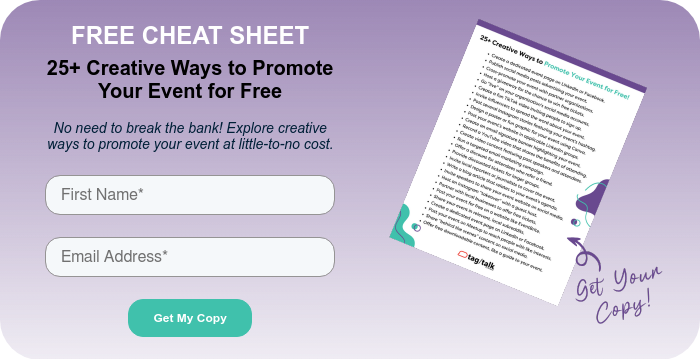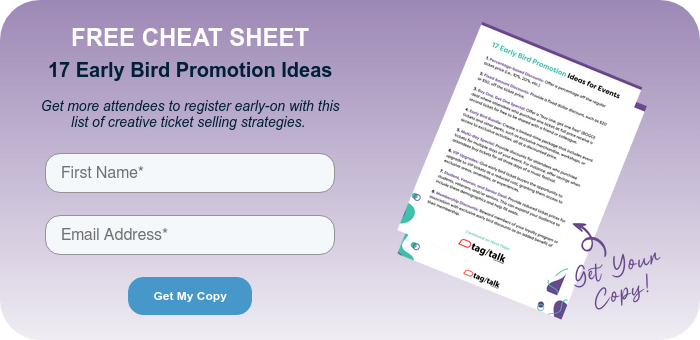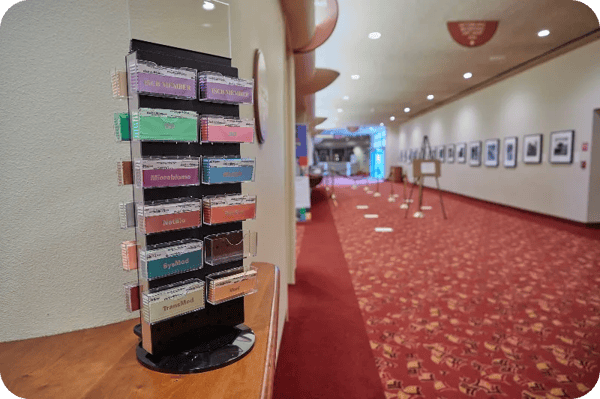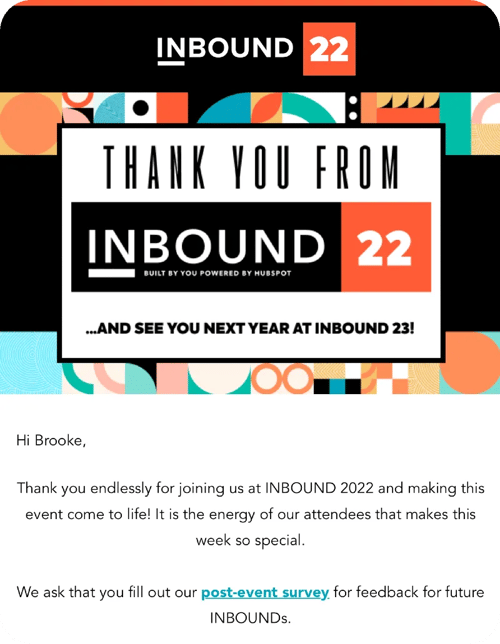You have your venue scoped out, your schedule in your head, your eye on keynote speakers – this whole event thing is pretty much figured out, right? Now you just need to get people through the door.
Conferences, meetings and events are most fun when they’re buzzing with excited people learning, networking, and having a great time together, but sometimes getting people to sign up for your event can be the most daunting part of the entire process.
If you’re overwhelmed with how to promote your event to the right group of people, you’ve come to the right place. Here are 11 tips from a seasoned digital marketer on how to promote your event and get people to actually show up.
Find what you're looking for:
1. Establish goals and KPIs
2. Create your event branding
3. Publish your event website
4. Start your email marketing strategy
5. Promote your event on social media
6. Experiment with paid advertising
7. Try out content marketing
8. Set partners up for success
9. Alert the press
10. Promote during your event
11. Promote after your event
BONUS: Your event promotion timeline

1. Nail down your event goals and KPIs
I know - it’s a boring place to start, but it’s crucial. The first step to promoting your event is determining what the point of your event is in the first place. Ask yourself: “What defines a successful event for my organization?” For most, the number of registrations is key, but you might want to break it down further into different categories, like:
- Total number of registrations
- Total number of early bird discount vs. late registrations
- Total number of virtual vs. in-person registrations
- Number of registrations by marketing source
- Marketing ROI or cost per registration
- Total number of engaged attendees
Consider what your goals are, and what would make your event a success in the eyes of stakeholders. Not only will it help you assess the success of this event, but it can also help you adjust your marketing strategy accordingly for next time.
2. Create your event branding
Your conference or event’s brand is incredibly important. If your event is an annual affair (or if you want it to become one), your event's brand should be something that people in your industry will recognize for years to come.
Your event branding might include (but is not limited to):
- Your event logo
- Two or more colors that are featured in your logo and marketing materials (be sure to pick specific hex codes to maintain consistency)
- One or two specific fonts used in your logo and other marketing materials
- A tag line that captures the vibe of your event and is featured prominently on your website and other marketing materials
- Various design elements (shapes, patterns, etc.) featured in marketing materials
Once you've made these decisions about your brand, make sure anyone who is promoting your event is on the same page when it comes to how this brand is conveyed through emails, social media, messaging, and so on. This will make sure your event appears professional and put-together.
One company that does a great job of marketing their conference is HubSpot with their annual INBOUND conference for marketers. While the look of the brand changes slightly each year, they consistently tie in HubSpot’s brand colors and culture. The short and simple name also keeps it memorable and makes it obvious what the topic of the conference is.
This graphic shows a few more aspects that set INBOUND's branding apart:
.webp?width=600&height=400&name=image%20(39).webp)
Once you’ve figured out your branding, determine what your event hashtag will be so you can start incorporating that into all social posts and messaging regarding your upcoming event. Most event organizers keep their hashtag short and simple, like #INBOUND24, but you could also add a fun spin, like #MarketersINBOUND.
Lastly, a small but simple way to get your event branding in front of potential attendees is to incorporate its elements into your email signature, as well as the signature of other key people associated with the event.
It may seem minor, but people notice changes to your email signature if you keep in regular contact with them. Adding your event's logo or a short CTA that links to your website is an easy way to drive up traffic and intrigue.
 An example of event branding and a call-to-action being used in an email signature
An example of event branding and a call-to-action being used in an email signature
3. Create a search engine optimized event landing page
Speaking of event websites and landing pages, you should make one!
If you don’t have the capabilities to create an entire website dedicated to your event, a landing page can work just as well. I would recommend a content platform like MailChimp or HubSpot, which will also allow you to easily incorporate a form into your page for people to either register for your event or sign up for an email list. Your mailing list allows attendees to get updates from you on things like registration information, speaker announcements, travel information, and more.
One event I attend every year and always kills it when it comes to their website design is the Guru email marketing conference.
.webp?width=600&height=297&name=image%20(36).webp) Check out the Guru website here.
Check out the Guru website here.
A few things I love about Guru's website are:
- There’s a colorful, attention-grabbing header, which captivates the site visitor immediately and adds credibility (20,000+ marketers).
- The "theme" of the event is clear and fun ("Back to the 80s").
- The primary call to action ("Register") is easy to find no matter what page of the site you're on.
- Speakers are highlighted with clear headshots and credentials.
- Sponsor logos are prominently featured but not at the expense of website functionality.
- The different content tracks are highlighted in a fun way and easy to find.
.webp?width=600&height=344&name=image%20(37).webp)
Other items you might want to add to your event’s landing page are any photos or videos from previous events, testimonials from past attendees, clear pricing, and an FAQ section so prospective attendees can get quick answers to any questions they may have.
When it comes to building your landing page, make sure you are targeting your ideal attendee. The Guru site works well for marketers, who tend to be more motivated by fun colors and graphic design. However, the same design might not work as well for something like a medical conference.
Don't forget to do keyword research ahead of time to get a better idea of what your audience might be searching when looking for an event like yours, and use that information to help with search engine optimization (SEO).
Tips for making your event website SEO-friendly:
- Use an SEO tool like MOZ or Semrush to find a high-volume, unique target keyword that your ideal attendee would search for and that you want your site to rank highly for
- Include that keyword in things like your URL, H1 and H2 headings, meta description, and site copy
- Use a site like Answer the Public to find out what questions people are asking about your keyword, and answer those questions on your website - either within the copy or on a designated FAQ page.
- Use an SEO tool or Google’s “related searches” to find related keywords or other content your website should mention too (this can also help you learn what topics should be included in your session agenda!)
SEO Tip: When you’re looking for a good target keyword, try finding one that has a balance of high search volume and low keyword difficulty. In the example below from Semrush, you’ll see “marketing conference” is a good keyword with a pretty high volume of 590 searches per month, and a low keyword difficulty of 26.
Some of the other keywords that have a lower volume and a higher difficulty may be more difficult to rank for, but they can still be sprinkled into your website content to build your credibility since Google perceives them as being related to one another.
- Are you an association? Click here for membership marketing tips, including strategies for making your association's website more SEO-friendly.
-1.webp?width=600&height=261&name=image%20(38)-1.webp)
4. Define your pre-event email strategy
Once you’ve created your website and built your email list, you’ll want to have an email marketing strategy for keeping your list engaged and disseminating information about your event. You can do this by scheduling regular emails or by creating an automated email workflow or "drip campaign" that sends pre-made emails at regular intervals. You can use a tool like HubSpot or Mailchimp to get started, but there are many other options as well. Pick a tool that best suits your needs (and budget)!
First, make sure that when someone fills out your form to register or get on your mailing list, they receive an automated email reply that goes out right away. This email should encourage them to follow your social profiles, share your event, and highlight key upcoming dates such as discount dates, keynote speaker announcements, registration deadlines, and so on.
If you really want to maximize your email potential, try segmenting your contact list based on information like job title, location, or industry. According to Mailmodo, emails with personalized subject lines can have up to double the open rate as non-personalized emails.
Personalization goes beyond just using their name in the subject line, though. For instance, if you know some attendees are coming from out of state, try including travel information in their emails, like the best hotels and restaurants in the area. If you know your attendees have multiple types of job functions, highlight the speakers and sessions that are most relevant to their specific roles.
Here is an example of a personalized email I received about three weeks before the INBOUND 2022 conference, which goes on to highlight sessions that I had specifically shown interest in by either adding them to my schedule or clicking links in previous emails:

Another simple way to get more engagement out of your emails is to create a sense of “FOMO” (fear of missing out) in your subject lines. Try something like, “⏰ Create your personalized schedule while you can!” or “👋 Your fellow marketers can’t wait to meet you!” rather than something generic, like, “Our schedule builder is live” or “Set up your attendee profile.”
Make sure you are also sending your emails during optimal send times. For us, sending emails on Tuesdays, Wednesdays and Thursdays works best, but it might be different for you. I have found that 11:30 am – 12:30 pm tends to be the best time to get good open rates, but click-through rates are the highest at the beginning or end of the workday.
Lastly, don’t forget to send follow-ups to anyone who signed up for your email list but hasn’t registered yet for the event. Try early bird discounts, last-minute reminders, and past attendee testimonials to encourage them to register. Be sure to filter out anyone who already has registered for the event to eliminate confusion or redundancy.

5. Promote your event on social media
Social media can be a beast, but it’s crucial to your event marketing strategy before, during, and after your event.
To get a better feel for what your social media strategy should entail, try using a website like SparkToro to do some audience research first. This tool will help you find topics and hashtags your ideal audience is already using on social media. It will also highlight popular figures and profiles in your industry.
You can even search specifically for "hidden gem" accounts, which will show you social profiles that may have a smaller following, but still a high affinity with your target group. Use this information to find speakers and influencers who can speak at or help promote your event
Here is an example of how SparkToro highlights key accounts and influencers based on what your audience is talking about online:
-1.webp?width=600&height=450&name=image%20(40)-1.webp)
Don’t forget to start using your event hashtag in your organic posts early and often, and to set up your social profiles accordingly. For instance, you can tweak your bios on Twitter, Instagram and TikTok to link directly to your event’s landing page instead of your usual destination while you’re in event promoting mode.
Make sure to post interesting content over the six months leading up to your event. Everyone loves seeing behind-the-scenes content, especially on TikTok or in stories, so post sneak peeks of the venue, décor, planning process, hints to upcoming speaker announcements, and so on. It’s hard to get traction on organic posts, so think outside of the box.
Another best practice is to use a social media scheduling tool to plan out your posts, such as Hootsuite, Buffer, or eclincher. Keeping up with social media can be a struggle, especially if you are actively using multiple platforms. A scheduling tool can help ease stress by monitoring all your inboxes in one location, and by helping you schedule multiple posts across multiple platforms all at once.
6. Promote your event with paid digital advertising
If you have the budget, it’s always a good idea to at least try out some digital advertising. If you’re new to the concept, I suggest running a simple Facebook ad targeted to your current page followers. Pick a bright, eye-catching image (try creating something in Canva), or a fun 30-second video (don’t forget to add captions!) with a simple call-to-action like “sign up,” which leads to your form.
Always lead people to a landing page with one very clear action that they can take. If you lead them to a full website with a navigation menu, users may get distracted by everything they can click on and navigate away from your form. Instead, make one page that stands on its own and entices visitors to take the exact action that will benefit you the most.
.webp?width=300&height=628&name=image%20(41).webp) |
.webp?width=302&height=521&name=image%20(42).webp) |
Examples of Facebook ads that that promote events - one using a more simplistic approach for the Tidal Wave Music Festival,
and one showing keynote speakers and sponsors for the Ad World marketing conference.
If you want to get a bit more advanced, you can try retargeting ads once you get enough traffic to your landing page or website. For instance, you can target anyone who has visited your page, but who has not filled out your form, with a slightly different message to entice them further. Try out a testimonial from a past attendee or highlight one of your keynote speakers!
Lastly, a fun way you can get people talking about your event is to run a contest. Try running an ad targeted at page followers, a contact list, or an interest group enticing them to follow your page and tag a friend for a chance to win a free VIP experience at your event. Spend wisely - set a goal beforehand for how much you are willing to spend on each entry.
7. Do pre-event content marketing
Content marketing is a huge part of any marketing strategy, and can bring in lots of organic traffic to your event's website. One of the easiest ways to do content marketing for your event is to get a couple of your speakers to write a guest blog post on key topics that they will address in their sessions at your event. You can host these blog posts on your website, and your speakers can promote the posts using their social platforms, personal email lists, and so on.
This is a mutually beneficial situation, because your speaker will get the opportunity to have their voice and expertise amplified, while you get free content to post to your site that promotes your event as one where industry trends thrive. You can also create links between the blog post and your speaker’s personal website, which has a positive effect on SEO for both sites.
While blogging is a huge part of content marketing, there are other forms that can be just as mutually beneficial. If you have the time and resources, try conducting an interview with one of your most well-known speakers. This will work especially well if you have an existing podcast with engaged listeners. If you do a video recorded interview, you can even use short clips to create social posts and digital ads to promote your event.
8. Set event influencers and partners up for success
When working with speakers, influencers and partners, make their lives as easy as possible. Your speakers will want to promote your event, because when your event gets more attendees, their session gets more participants. However, they're also very busy! They likely don't have time to craft unique social posts to promote your event, so give them the tools they need to be successful.
You can set your partners and speakers up for success by providing them with copy-and-paste messaging and shareable graphics they can use to easily post to their social media profiles.
-1.webp?width=600&height=604&name=image%20(43)-1.webp) An example of a LinkedIn post by Kath Pay, a presenter at the Guru email marketing conference,
An example of a LinkedIn post by Kath Pay, a presenter at the Guru email marketing conference,
where graphics, copy and links were likely provided by Guru's team for easy sharing.
One of my favorite ways to get influencers involved in event marketing is to provide them with an affiliate promotional code. This is a special link or code that the influencer will share with their audience that they can use when they register for your event, which will tie back to the influencer. You can set up terms ahead of time, and even give the influencers a percentage of revenue generated from registrants that came from them to incentivize sharing even more.
9. Use the press to promote your event
Traditional forms of media are still relevant and can help you promote your event. If your event is going to drive a lot of travel and local business to your community, people will want to know about it. Try reaching out to local media companies and news outlets so they can give your event a shoutout.
Similarly, it can still be worth your time to put out a press release. They are quick to write up, and while submitting it to a company like Cision can be a bit pricey, it can have far-reaching positive effects for the right event. Press releases also help you establish connections with the media, and they provide more credibility to your organization and event.
Don’t forget to submit your event information to key associations within your industry. For instance, a marketing conference would be a relevant event for an organization like the American Marketing Association (AMA) or the Content Marketing Institute (CMI) to promote to their readers.

10. Continue promoting your event while it's happening
Once your event starts and your doors open, don't stop promoting! Incentivize attendees to use your event hashtag and create user-generated content (UGC) during your event.
Some of my favorite events have had beautiful photo opportunities at the ready so attendees get excited to post to their social media profiles. This works especially well if your attendees are Instagram or TikTok users. You can also feature a badge ribbon wall at your event with ribbons that feature your event hashtag and other buzzworthy, industry-relevant ideas or jokes that people can add to their badge. Ribbons are big crowd-pleasers and can be seen all over social media during events.
 A biology-themed badge ribbon wall featured at the ISMB conference in Madison, Wisconsin
A biology-themed badge ribbon wall featured at the ISMB conference in Madison, Wisconsin
Next, consider hosting giveaways during your event. I recently attended a conference where they gave away 50 copies of a book written by the keynote speaker, and they announced the winners at the last session of the day. This is a great way to get people talking, as the winners will want to share their prize, and it will keep attendees engaged all day long through the last session.
Be sure to have someone whose sole job is to post live updates and engage with attendees on social media in real time during your event. Have them film short clips during sessions and post them to TikTok or stories in real time. Attendees will want to share all the great content and experiences they’ve had, and non-attendees might feel left out and be more likely to attend next year.
This spokesperson will also be able to quickly respond to user posts during your event, both positive and negative. As many event professionals would agree, not everything goes to plan. The best way to keep attendees satisfied when things go wrong is to kindly acknowledge any issues and let them know you are actively working on it. The last thing you want is to completely miss or accidentally ignore on-site issues during your event.
Another great day at @INBOUND. Saw Dr. Jane Goodall, Viola Davis and @worldata who all give lots of tips of wisdom. And had some kick ass pizza at Otto Pizzeria! #BlackatInbound #INBOUND2022 pic.twitter.com/Ed2JG2PGtN
— Marcea Cazel 🕶🛶✍🏾 (@MarceaCazel) September 9, 2022
11. When it's over, start promoting for next time
Event promotion extends after your event as well. Make sure you send out a post-event thank you email to all your attendees thanking them for coming. This is the perfect opportunity to thank everyone who made the event possible, distribute a post-event survey for attendee feedback, and announce information for next year's event.
Another simple and fun idea is to put together an event wrap-up blog post, where you highlight the best sessions and tidbits of information learned at your event. You can embed your attendees’ social posts, include quotes or videos from sessions, and add testimonials if you have them.
Lastly, consider making your sessions available on demand digitally after your event has concluded. This is a great way to keep attendees thinking about your event even after it’s over, because they’ll be able to virtually attend any sessions they missed out on. This is a big positive for the overall attendee experience, and it will increase the general appeal of your event in the future.
 The post-show email with attendee survey sent out by HubSpot after INBOUND 2022
The post-show email with attendee survey sent out by HubSpot after INBOUND 2022
Now that you hopefully have some good ideas in mind, the next step is to figure out a schedule for when to implement each marketing strategy. I’ve added a timeline below as a rough guide to get you started, but it’s certainly something you can tweak to suit your needs.

Event Promotion Timeline
1 year before your event
- Set up a simple form where people can sign up to stay updated on important dates, speaker announcements, early bird registration, etc.
- Start working on event branding, either from scratch or making tweaks to the previous years’
- Start setting up personalized email workflows
- Create a public Facebook event so prospective attendees can signify their interest
6 months before your event
- Finalize your event branding
- Start using your event hashtag in social media posts
- Launch your event website or landing page
- Post about your event in social media groups
- Start producing content marketing assets – aim for one piece of content per month (blogs, podcasts, YouTube videos, etc.)
- Promote early bird pricing
- Promote early speakers and sponsors
- Ramp up your email marketing strategy with more frequent emails
3-4 months before your event
- Send last-minute early bird pricing reminders
- Launch paid advertising to internal lists, lookalike lists, and interest groups
- Have influencers and partners start posting about your event
- Run a social media contest for free entry or VIP experience
1-2 months before your event
- Launch retargeting ads
- Encourage attendees to download your event app if you have one
- Post behind-the-scenes content on social media, especially TikTok and Instagram
2-4 weeks before your event
- Use last call messaging
- Send a finalized schedule to attendees so people can plan their experience
During your event
- Encourage hashtag usage
- Engage with attendees and answer their questions promptly
- Post about upcoming speaker sessions
- Post share-worthy video highlights to social media
- Take plenty of photos
After your event
- Send a thank you email to attendees
- Send a post-event survey
- Write an event wrap-up blog
- Post about your successful event on social media and link to a form where people can sign up to learn about next year’s event
- Determine the success of your marketing efforts and where you can improve for next year
- The cycle begins again!
Promoting your event can be overwhelming, but hopefully these tips make it a bit more approachable. Don’t worry about implementing every single idea - doing even a few of these things will put you ahead of the game and have a big impact on your bottom line. Your marketing strategy will go through constant changes and iterations, so you can always go bigger and bolder next year!



Submit a Comment